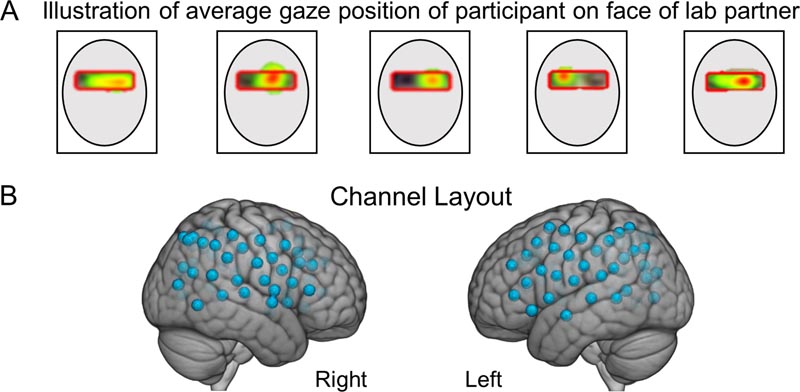Summary Reluctance to make eye contact during natural interactions is a core diagnostic criterion for autism spectrum disorder (ASD). However, the underlying neural correlates for eye contacts in ASD are unknown, and diagnostic biomarkers are active areas of research. Here, neuroimaging, eye tracking, and pupillometry data were acquired simultaneously using two-person functional near-infrared spectroscopy (fNIRS) during live “in-person” eye contact and gaze on a video face for typically-developed (TD). ) and participants with ASD to identify the neural correlates of live eye contact in both groups. Comparisons between ASD and TD showed decreased right dorsal-parietal activity and increased right ventral temporal-parietal activity for ASD during live eye contact (p≤0.05, FDR corrected) and reduced inter-brain coherence consistent with neural systems atypical for live eye contact. Hypoactivity of right dorso-parietal regions during eye contact in ASD was further associated with gold standard measures of social performance by correlating neural responses and individual measures of: ADOS-2, Autism Diagnostic Observation Schedule , 2nd Edition (r = -0.76, -0.92 and -0.77); and SRS-2, Social Responsiveness Scale, Second Edition (r = -0.58). Findings indicate that as categorized social ability decreases, neural responses to actual eye contact in the right dorsal parietal region also decrease consistent with a neural correlate for social characteristics in ASD. |

A. Examples of average gaze positions of participants when viewing the lab partner’s face. The red box illustrates the “eye box” of the target, and the color gradient from red to green indicates the percentage of “target hits” in the eye box during an entire run. B. fNIRS channel layout. The left and right hemispheres of a single rendered brain illustrate the median locations (blue dots) for 58 channels per participant. Montreal Neurological Institute (MNI) coordinates were determined for each channel by digitizing the emitter and detector locations relative to the anterior, posterior, dorsal, and lateral fiduciary markers based on the standard 10–20 system.
Comments
A hallmark of autism spectrum disorder, ASD, is a reluctance to make eye contact with others under natural conditions. Although eye contact is a critically important part of everyday interactions, scientists have been limited in studying the neurological basis of live social interaction with eye contact in ASD due to the inability to image the brain of two people simultaneously.
However, using innovative technology that allows imaging of two people in natural, live conditions , Yale researchers have identified specific brain areas in the dorsal parietal region of the brain associated with the social symptomatology of autism. The study, published in the journal PLOS ONE, finds that these neural responses to direct contact with the face and eyes may provide a biomarker for the diagnosis of ASD, as well as proof of the effectiveness of autism treatments.
“Our brains are hungry for information about other people, and we need to understand how these social mechanisms work in the context of a real, interactive world in both typically developed individuals and individuals with ASD,” said co-author Joy Hirsch. , Elizabeth Mears and House Jameson Professor of Psychiatry, Comparative Medicine and Neuroscience at Yale.
The Yale team, led by Hirsch and James McPartland, Harris Professor at the Yale Child Study Center, analyzed brain activity during brief social interactions between pairs of adults, each of which included one typical participant and one with ASD, using spectroscopy. functional near-infrared imaging, a non-invasive optical neuroimaging method. Both participants were fitted with caps with many sensors that beamed light into the brain and also recorded changes in light signals with information about brain activity during face gaze and eye contact.
The researchers found that during eye contact, participants with ASD had significantly reduced activity in a region of the dorsal parietal cortex compared to those without ASD. Furthermore, the more severe the overall social symptoms of ASD as measured by ADOS ( Autism Diagnostic Observation Schedule, 2nd Edition ) scores , the less activity was observed in this brain region. Neural activity in these regions was synchronous among typical participants during real eye contact, but not during looking at a video face. This typical increase in neural coupling was not observed in ASD and is consistent with difficulties in social interactions.
“We now not only have a better understanding of the neurobiology of autism and social differences, but also of the underlying neural mechanisms that drive typical social connections,” Hirsch said.
















